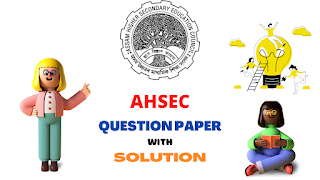ASSEB| CLASS 12| EDUCATION| QUESTION PAPER - 2025| H.S. 2ND YEAR
2025
EDUCATION
Full Marks: 100
Pass Marks: 30
Time: Three hours
The figures in the margin indicate
full marks for the questions.
1. Answer the following questions: (any twelve) 1×12=12
Fill in the
blanks:
(a) The Indira
Gandhi National Open University was established in _______.
(b) On the basis
of the recommendation of _______Commission Government of Assam decided to
change some high schools into multipurpose school.
(c) Prior to
_______secondary education in Assam was controlled by the Gauhati University
and Government of Assam.
(d) The concept
of correspondence education was first introduced by______ in 1840.
(e) The name of
the largest Open University of the world is _______.
(f) World
Environment Day is celebrated on ________.
(g) Ivan Pavlov
was a Russian Physiologist and ________.
(h) Conditioning
method of learning establishes bond between natural tendency and _______.
Give short
answer in one sentence:
(i) Which
Education Commission suggested the 10 +2+3 structure of education?
(j)
"Non-formal education differs from formal education in the sense that it
takes place outside the formal school system." Who said this?
(k) "Physical
education is the sum of changes in the individual caused by experiences
centering motor activity." Who said this?
(l)
"Learning is both acquisition and retention of habit, knowledge and
attitude." Who said this statement?
(m) What is
voluntary or volitional attention?
(n) What is image
memory?
(o) What is mode?
(p) Write the
formula for finding out first quartile from group data.
2. Answer any twelve of the following questions: 2x12=24
(a) Write two
suggestions of Kothari Commission regarding education and productivity.
(b) Write two
importance of vocationalisation of secondary education in the present context.
(c) Write two
objectives of "Operation Blackboard" scheme.
(d) Define the
concept of physical education.
(e) What do you
mean by value education?
(f) Define the
concept of women empowerment.
(g) Write two
differences between maturation and learning.
(h) What do you
mean by law of readiness in learning?
(i) What is
retention?
(j) What is
retroaction inhibition?
(k) Write any
two characteristics of attention.
(l) Define the
concept of mental health and hygiene.
(m) Write two
objectives of mental hygiene.
(n) Define the
preventive function of mental hygiene.
(o) Find the
Median and Mode from the following data: 1+1=2
58, 42, 30,
64, 57, 42, 34, 53, 44 and 38
(p) Write two
merits of quartile deviation as a measurment of variability.
3. Answer any ten of the following questions: 4×10=40
(a) Write four
important provisions of the Secondary Education Act of Assam (1961).
(b) Write four
important functions of Board of Secondary Education, Assam'.
(c) Discuss four
major problems of secondary education in Assam.
(d) Write four
objectives of non-formal education.
(e) Write four
advantages of correspondence education.
(f) Discuss four
significant aspects of distance education.
(g) How can the
physical education be imparted in school? Discuss.
(h) Discuss the
need and importance of value education.
(i) Write four
important characteristics of insightful learning.
(j) Discuss the
educational significance of law of effect.
(k) Write four
physical causes of forgetting.
(l)
"Attention and interest are like two sides of the same coin."
Discuss.
(m) Discuss four
characteristics of a mentally healthy individual.
(n) Discuss the
importance of statistics in education and psychology.
(o) What is frequency polygon? Draw a frequency polygon
from the following distribution table: (use graph paper) 1+3=4
|
Class Interval |
Frequency |
|
80-84 75-79 70-74 65-69 60-64 55-59 50-54 45-49 40-44 |
1 3 6 9 12 8 6 3 2 |
|
|
N = 50 |
4. Answer any four of the following questions: 6×4=24
(a) What is
environmental education? Discuss the principles of environmental education.
2+4=6
(b) What is
population education? How can the population education be imparted in
educational institution? Discuss. 2+4-6
(c) What is
connectionism in learning? Discuss the educative value of trial-and-error
method of learning. 2+4-6
(d) Describe the
meaning and process of memory. Briefly discuss four marks of good memory. 2+4=6
(e) What is
attention? Discuss the importance of attention and interest in education. 2+4-6
(f) What is
mean? Compute mean from the following distribution table by Assumed Mean
method: 1+5=6
|
Class Interval |
Frequency |
|
65-69 60-64 55-59 50-54 45-49 40-44 35-39 30-34 25-29 20-24 15-19 |
2 3 4 7 8 16 9 4 3 2 2 |
|
|
N = 60 |
***
BUY E-BOOK (PDF FILE)
[TO SEE FULL SOLUTION]
(Chapter wise Notes, Exam Question Papers solved, MCQ solved) [ARTS, COMMERCE, SCIENCE]
|
DOWNLOAD PAGE LINK:-CLICK HERE |
ASSEB/ AHSEC PAGE LINK - CLICK HERE

